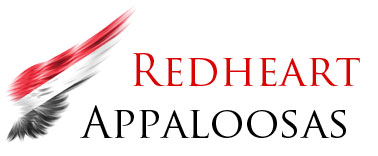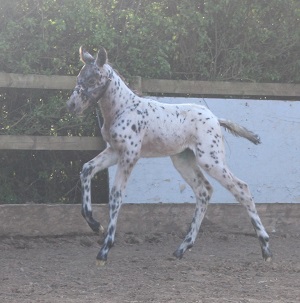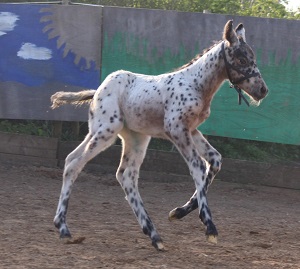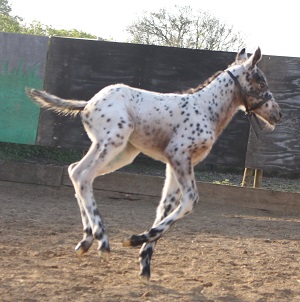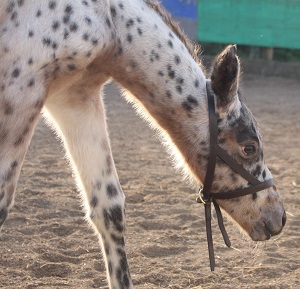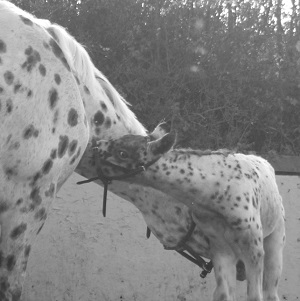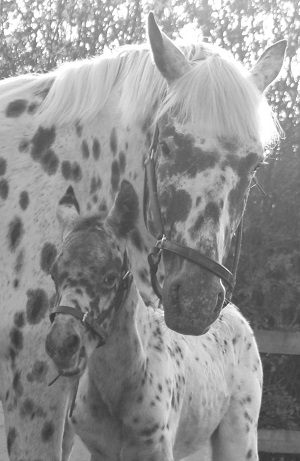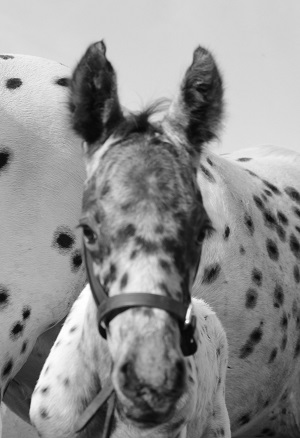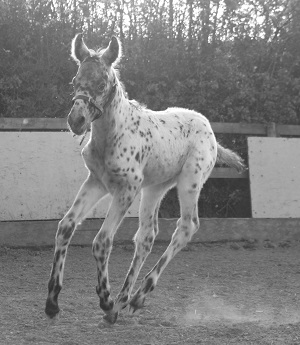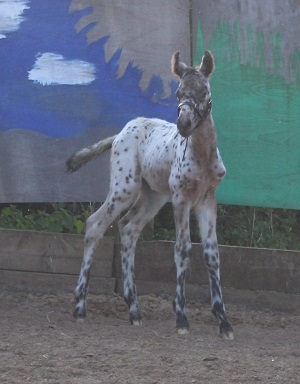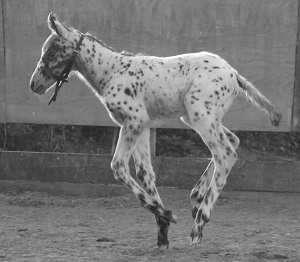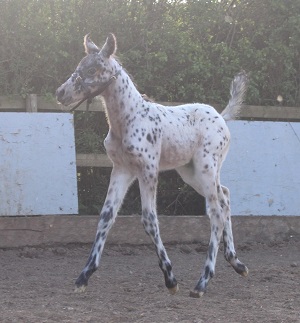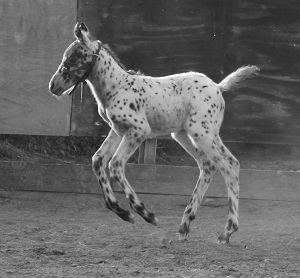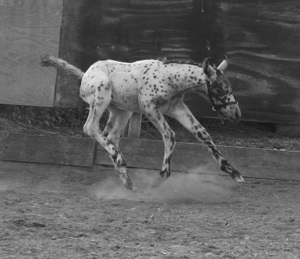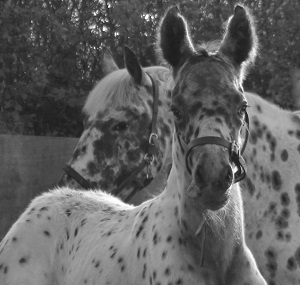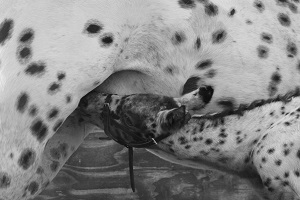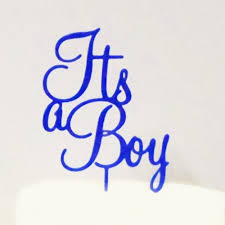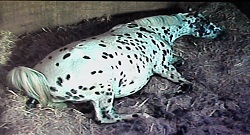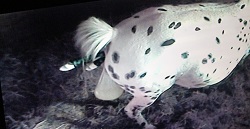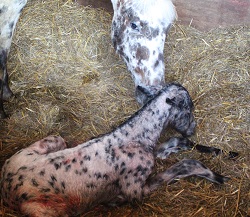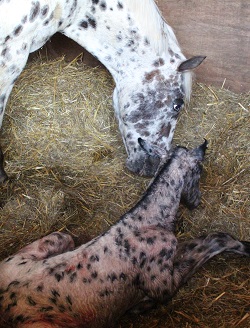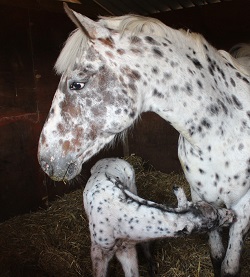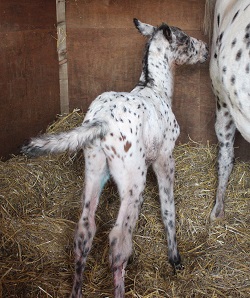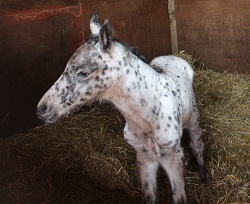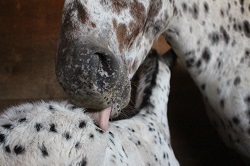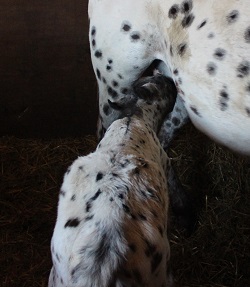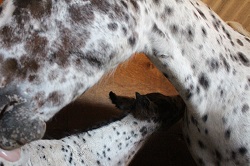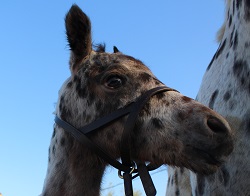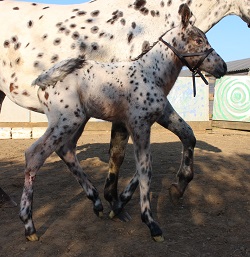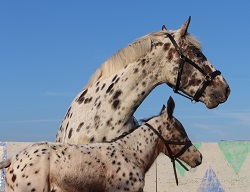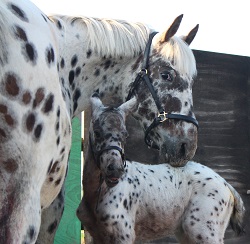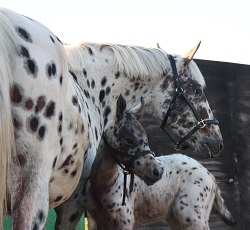Breaking news……..
Last month it was announced the Veterinary Genetics Lab at UC Davis began offering the DNA test for PATN1.
“Since the discovery of LP, the main gene that controls appaloosa spotting patterns and associated traits, breeders have been anticipating DNA tests for the genes that work with LP to produce white appaloosa patterning.
We are happy to announce that the white pattern modifier gene with the largest pattern causing effect, termed Pattern-1 for “first pattern gene” or PATN1 for short, can now be DNA tested for.
A mutation in PATN1 was identified that is associated with increased amount of white in LP horses. This mutation (in combination with LP) behaves in a dominant fashion which means you only need one copy of the PATN1 mutation to observe large amounts of white as long as LP is present.”
Here is the link to their horse test page: The Veterinary Genetics Laboratory (VGL)
I am sure, I am not the only excited owner / breeder that has anxiously been awaiting their horse’s results. The Appaloosa Project team continues to teach us via their Electronic Classroom keeping us up to date when new information is discovered. The future in genetics continues to help improve the Appaloosa breed by allowing us breeders to act on their knowledge when offered to us. I am sure other test will be available soon but for the present moment here are the results to date and the past photos of the Redheart Appaloosas.
Peyres Catori Cat
Leopard Complex LP/lp
Heterozygous, carries one copy of the Appaloosa LP gene. Is a carrier of CSNB
Grey gene gg
Negative for the Grey gene
PSSM1 n/n
Negative for the PSSM Type 1 gene mutation
Red factor E/e
Both black & red factors detected. Either E or e transmitted to offspring. Basic colour is black, bay or brown in the absence of other modifying genes.
Agouti A/a
Black pigment distributed in point’s pattern. Basic colour is bay or brown in the absence of other modifying genes.
PATTERN-1 N/PATN1
1 copy of PATN1, 50% of offspring will inherit the modifier mutation. In order for high levels of white spotting to be visible the foal must inherit the LP gene.

Peyres Catori Cat (Past & Present)

Princesse Pascale
Leopard Complex LP/lp
Heterozygous, carries one copy of the Appaloosa LP gene. Is a carrier of CSNB
Gray gene gg
Negative for the Grey gene
PSSM1 n/n
Negative for the PSSM Type 1 gene mutation
Red factor E/E
No red factor detected. Cannot have red foals regardless of the colour of stallion. Basic colour is black, bay or brown in the absence of other modifying genes.
Agouti A/a
Black pigment distributed in point’s pattern. Basic colour is bay or brown in the absence of other modifying genes.
PATTERN-1 N/PATN1
1 copy of PATN1, 50% of offspring will inherit the modifier mutation. In order for high levels of white spotting to be visible the foal must inherit the LP gene.

Princesse Pascale (Past & Present)

Hevans EV Catorrius
Leopard Complex lp/lp
Negative for the Appaloosa LP gene, has no appaloosa characteristics.
Gray gene gg
Negative for the Grey gene
PSSM1 n/n
Negative for the PSSM Type 1 gene mutation
Red factor E/e
Both black & red factors detected. Either E or e transmitted to offspring. Basic colour is black, bay or brown in the absence of other modifying genes.
Agouti A/a
Black pigment distributed in point’s pattern. Basic colour is bay or brown in the absence of other modifying genes.
PATTERN-1 N/PATN1
1 copy of PATN1, 50% of offspring will inherit the modifier mutation. In order for high levels of white spotting to be visable the foal must inherit the LP gene.
In terms of breeding it is very beneficial here at Redheart Appaloosas to have Hevans EV Catorrius results. He is N/PATN1. There is no way to tell by looking at him if the gene was present or not. Bred from two heterozygous (LP/lp) horses it was hopeful but not factual. As a future stallion it is now evident he is quite valuable in terms of breeding and doesn’t deserve to be over looked because he doesn’t have spots! A stallion with the genotype PATN1/patn1 would most definitely produce foals with a higher level of white appaloosa patterning in comparison to the foals produced by a stallion without PATN1.

Hevans EV Catorrius (Past & Present)

Redheart Pascalius
Leopard Complex LP/lp
Heterozygous, carries one copy of the Appaloosa LP gene .Is a carrier of CSNB
Gray gene gg
Negative for the Grey gene
PSSM1 n/n
Negative for the PSSM Type 1 gene mutation
Red factor E/E
No red factor detected. Cannot have red foals regardless of the colour of the stallion. Basic colour is black, bay or brown in the absence of other modifying genes.
Agouti a/a
Only recessive allele detected. Black pigment distributed uniformly. Basic colour is black in the absence of other modifying genes.
PATTERN-1 N/N
No copies of PATN1
This filly was a deep black velvet colour when born without a coat pattern except one white spot on her back. She has all the characteristics and it is no surprise he result id N/N for PATN1 even though LP is present. She is two years old now and has roaned out beautifully.

Redheart Pascalius (Past & Present)

Redheart Cateaster
Leopard Complex LP/LP
Homozygous, carries two copies of the Appaloosa LP gene and is affected by CSNB
Grey gene gg
Negative for the Grey gene
PSSM1 n/n
Negative for the PSSM Type 1 gene mutation
Red factor E/e
Both black & red factors detected. Either E or e transmitted to offspring. Basic colour is black, bay or brown in the absence of other modifying genes.
Agouti A/a
Black pigment distributed in point’s pattern. Basic colour is bay or brown in the absence of other modifying genes.
PATTERN-1 N/PATN1
1 copy of PATN1, 50% of offspring will inherit the modifier mutation. In order for high levels of white spotting to be visible the foal must inherit the LP gene.
This filly has not changed much in coat pattern but her colour has lightened. We should see some spots appear after her winter / foal coat has shed, the skin pigment is certainly spotted on her hind legs.

Redheart Cateaster (Past & Present)

Testing for both LP and PATN1 is recommended for breeders interested in producing Leopard Complex-spotted horses.
The past has been guess work and the present has given us factual evidence enabling us to cross
Appaloosa x Appaloosa for the desired traits we seek.
